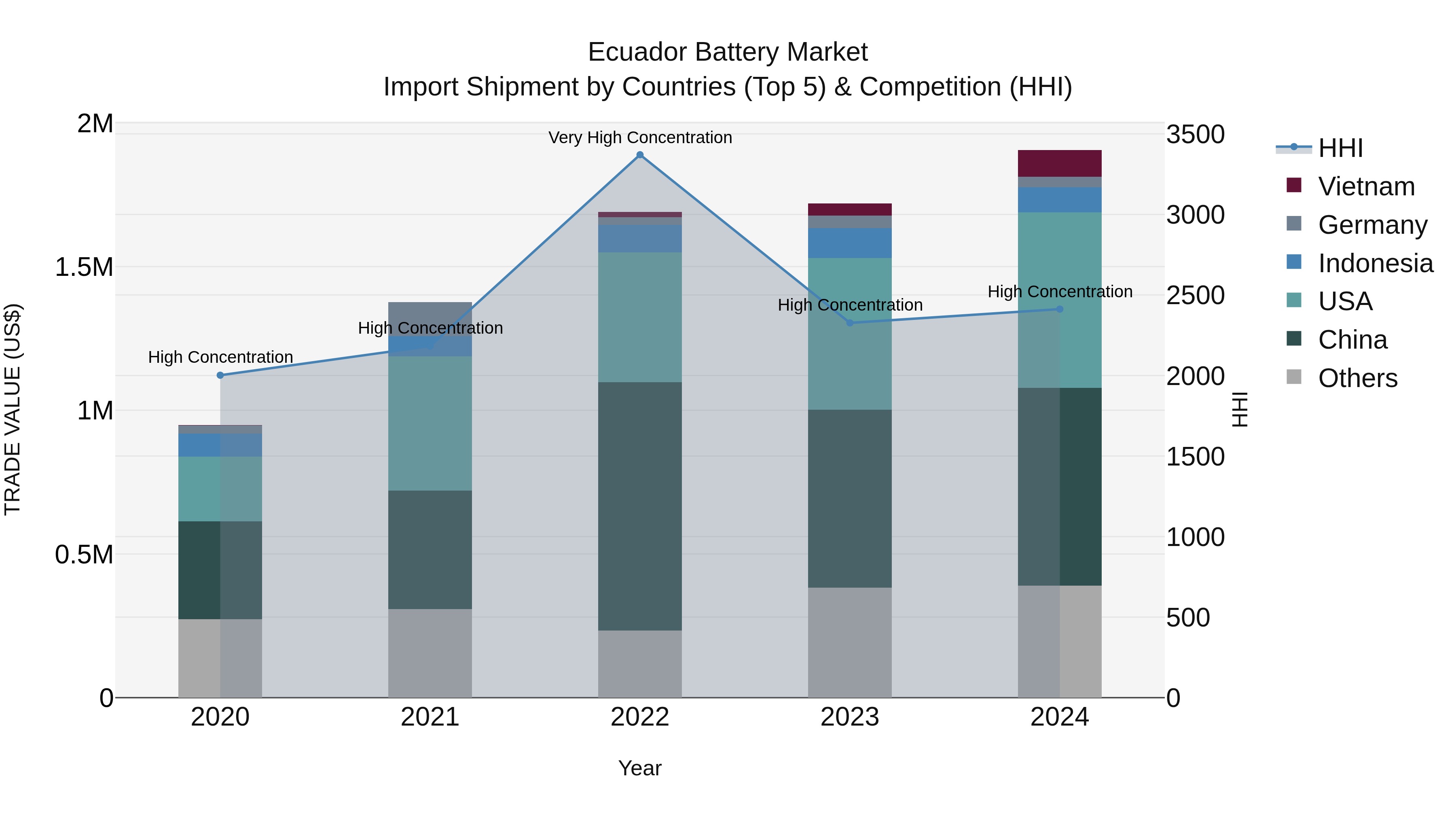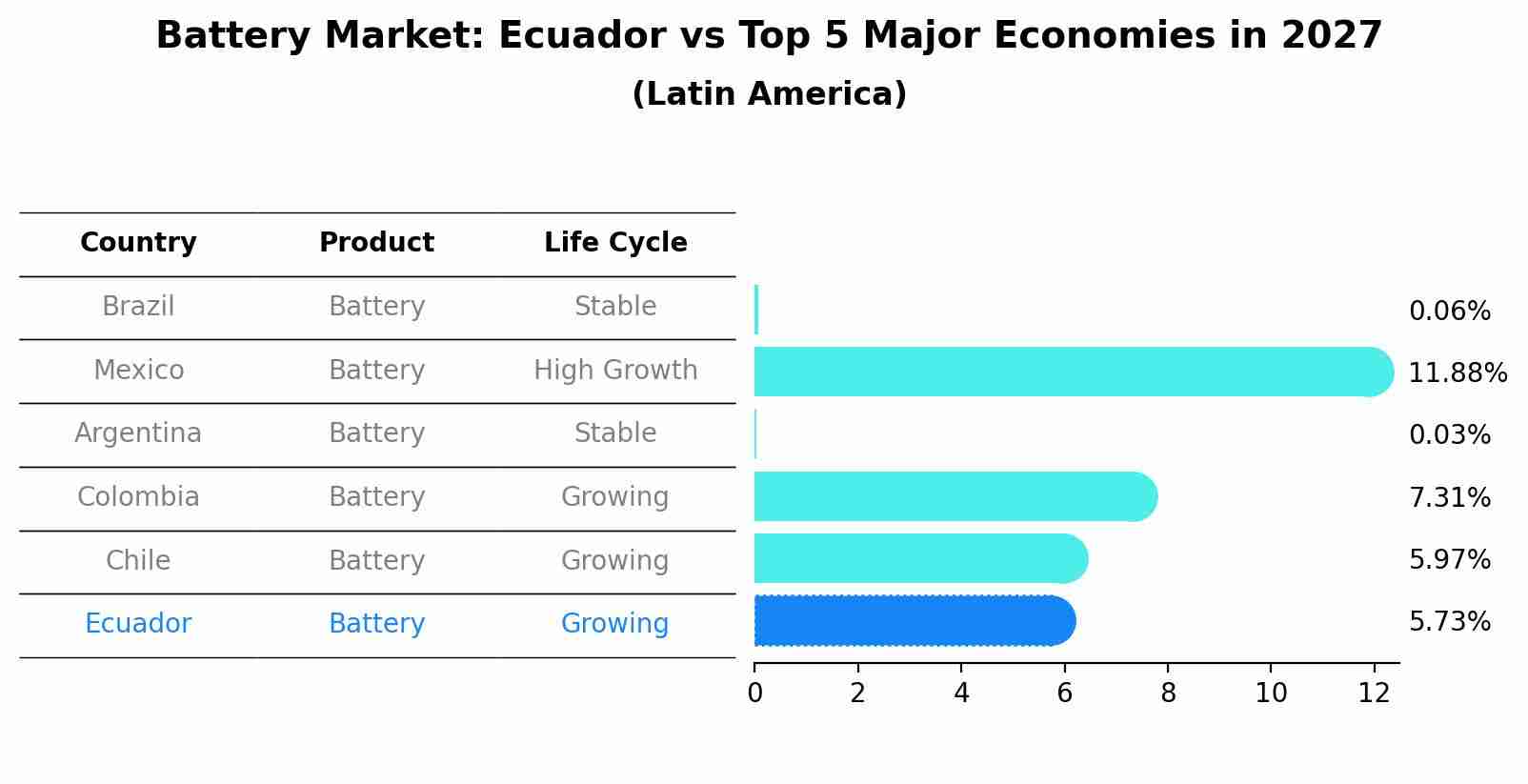Ecuador Battery Market (2025-2031) | Revenue, Trends, Size, Analysis, Share, Growth, Companies, Value, Outlook, Forecast, Segmentation & Industry
| Product Code: ETC4776058 | Publication Date: Nov 2023 | Updated Date: Oct 2025 | Product Type: Market Research Report | |
| Publisher: 6Wresearch | No. of Pages: 60 | No. of Figures: 30 | No. of Tables: 5 | |
Ecuador Battery Market Top 5 Importing Countries and Market Competition (HHI) Analysis
Ecuador`s battery import shipments in 2024 continued to be dominated by key exporters such as China, USA, Vietnam, Indonesia, and Hong Kong. Despite high concentration with a high Herfindahl-Hirschman Index (HHI) in 2024, the sector demonstrated strong growth with a Compound Annual Growth Rate (CAGR) of 19.06% from 2020 to 2024. The growth momentum remained robust in 2024, with a growth rate of 10.82% compared to the previous year. This data suggests a thriving Market Top 5 Importing Countries and Market Competition (HHI) Analysis for battery imports in Ecuador, driven by partnerships with top exporting countries.

Battery Market: Ecuador vs Top 5 Major Economies in 2027 (Latin America)
By 2027, the Battery market in Ecuador is anticipated to reach a growth rate of 5.73%, as part of an increasingly competitive Latin America region, where Brazil remains at the forefront, supported by Mexico, Argentina, Colombia and Chile, driving innovations and market adoption across sectors.

Key Highlights of the Report:
- Ecuador Battery Market Outlook
- Market Size of Ecuador Battery Market, 2024
- Forecast of Ecuador Battery Market, 2031
- Historical Data and Forecast of Ecuador Battery Revenues & Volume for the Period 2021-2031
- Ecuador Battery Market Trend Evolution
- Ecuador Battery Market Drivers and Challenges
- Ecuador Battery Price Trends
- Ecuador Battery Porter`s Five Forces
- Ecuador Battery Industry Life Cycle
- Historical Data and Forecast of Ecuador Battery Market Revenues & Volume By Product for the Period 2021-2031
- Historical Data and Forecast of Ecuador Battery Market Revenues & Volume By Lead Acid for the Period 2021-2031
- Historical Data and Forecast of Ecuador Battery Market Revenues & Volume By Lithium Ion for the Period 2021-2031
- Historical Data and Forecast of Ecuador Battery Market Revenues & Volume By Nickel Metal Hydride for the Period 2021-2031
- Historical Data and Forecast of Ecuador Battery Market Revenues & Volume By Nickel Cadmium for the Period 2021-2031
- Historical Data and Forecast of Ecuador Battery Market Revenues & Volume By Others for the Period 2021-2031
- Historical Data and Forecast of Ecuador Battery Market Revenues & Volume By Application for the Period 2021-2031
- Historical Data and Forecast of Ecuador Battery Market Revenues & Volume By Automotive Batteries for the Period 2021-2031
- Historical Data and Forecast of Ecuador Battery Market Revenues & Volume By Industrial Batteries for the Period 2021-2031
- Historical Data and Forecast of Ecuador Battery Market Revenues & Volume By Portable Batteries for the Period 2021-2031
- Ecuador Battery Import Export Trade Statistics
- Market Opportunity Assessment By Product
- Market Opportunity Assessment By Application
- Ecuador Battery Top Companies Market Share
- Ecuador Battery Competitive Benchmarking By Technical and Operational Parameters
- Ecuador Battery Company Profiles
- Ecuador Battery Key Strategic Recommendations
Frequently Asked Questions About the Market Study (FAQs):
1 Executive Summary |
2 Introduction |
2.1 Key Highlights of the Report |
2.2 Report Description |
2.3 Market Scope & Segmentation |
2.4 Research Methodology |
2.5 Assumptions |
3 Ecuador Battery Market Overview |
3.1 Ecuador Country Macro Economic Indicators |
3.2 Ecuador Battery Market Revenues & Volume, 2021 & 2031F |
3.3 Ecuador Battery Market - Industry Life Cycle |
3.4 Ecuador Battery Market - Porter's Five Forces |
3.5 Ecuador Battery Market Revenues & Volume Share, By Product, 2021 & 2031F |
3.6 Ecuador Battery Market Revenues & Volume Share, By Application, 2021 & 2031F |
4 Ecuador Battery Market Dynamics |
4.1 Impact Analysis |
4.2 Market Drivers |
4.2.1 Increasing adoption of electric vehicles in Ecuador |
4.2.2 Growing demand for renewable energy storage solutions |
4.2.3 Government initiatives promoting energy efficiency and sustainability |
4.3 Market Restraints |
4.3.1 High initial costs associated with battery technologies |
4.3.2 Limited availability of raw materials for battery production |
4.3.3 Lack of established recycling infrastructure for batteries |
5 Ecuador Battery Market Trends |
6 Ecuador Battery Market Segmentations |
6.1 Ecuador Battery Market, By Product |
6.1.1 Overview and Analysis |
6.1.2 Ecuador Battery Market Revenues & Volume, By Lead Acid, 2021-2031F |
6.1.3 Ecuador Battery Market Revenues & Volume, By Lithium Ion, 2021-2031F |
6.1.4 Ecuador Battery Market Revenues & Volume, By Nickel Metal Hydride, 2021-2031F |
6.1.5 Ecuador Battery Market Revenues & Volume, By Nickel Cadmium, 2021-2031F |
6.1.6 Ecuador Battery Market Revenues & Volume, By Others, 2021-2031F |
6.2 Ecuador Battery Market, By Application |
6.2.1 Overview and Analysis |
6.2.2 Ecuador Battery Market Revenues & Volume, By Automotive Batteries, 2021-2031F |
6.2.3 Ecuador Battery Market Revenues & Volume, By Industrial Batteries, 2021-2031F | 6.2.4 Ecuador Battery Market Revenues & Volume, By Portable Batteries, 2021-2031F |
7 Ecuador Battery Market Import-Export Trade Statistics |
7.1 Ecuador Battery Market Export to Major Countries |
7.2 Ecuador Battery Market Imports from Major Countries |
8 Ecuador Battery Market Key Performance Indicators |
8.1 Average cost per kilowatt-hour (kWh) of battery storage systems |
8.2 Percentage increase in electric vehicle sales in Ecuador |
8.3 Number of new energy storage projects utilizing batteries in Ecuador |
9 Ecuador Battery Market - Opportunity Assessment |
9.1 Ecuador Battery Market Opportunity Assessment, By Product, 2021 & 2031F |
9.2 Ecuador Battery Market Opportunity Assessment, By Application, 2021 & 2031F |
10 Ecuador Battery Market - Competitive Landscape |
10.1 Ecuador Battery Market Revenue Share, By Companies, 2024 |
10.2 Ecuador Battery Market Competitive Benchmarking, By Operating and Technical Parameters |
11 Company Profiles |
12 Recommendations | 13 Disclaimer |
- Single User License$ 1,995
- Department License$ 2,400
- Site License$ 3,120
- Global License$ 3,795
Search
Related Reports
- Vietnam System Integrator Market (2025-2031) | Size, Companies, Analysis, Industry, Value, Forecast, Growth, Trends, Revenue & Share
- ASEAN and Thailand Brain Health Supplements Market (2025-2031) | Strategy, Consumer Insights, Analysis, Investment Trends, Opportunities, Growth, Size, Share, Industry, Revenue, Segments, Value, Segmentation, Supply, Forecast, Restraints, Outlook, Competition, Drivers, Trends, Demand, Pricing Analysis, Competitive, Strategic Insights, Companies, Challenges
- ASEAN Bearings Market (2025-2031) | Strategy, Consumer Insights, Analysis, Investment Trends, Opportunities, Growth, Size, Share, Industry, Revenue, Segments, Value, Segmentation, Supply, Forecast, Restraints, Outlook, Competition, Drivers, Trends, Demand, Pricing Analysis, Competitive, Strategic Insights, Companies, Challenges
- Europe Flooring Market (2025-2031) | Outlook, Share, Industry, Trends, Forecast, Companies, Revenue, Size, Analysis, Growth & Value
- Saudi Arabia Manlift Market (2025-2031) | Outlook, Size, Growth, Trends, Companies, Industry, Revenue, Value, Share, Forecast & Analysis
- Uganda Excavator, Crane, and Wheel Loaders Market (2025-2031) | Strategy, Consumer Insights, Analysis, Investment Trends, Opportunities, Growth, Size, Share, Industry, Revenue, Segments, Value, Segmentation, Supply, Forecast, Restraints, Outlook, Competition, Drivers, Trends, Demand, Pricing Analysis, Competitive, Strategic Insights, Companies, Challenges
- Rwanda Excavator, Crane, and Wheel Loaders Market (2025-2031) | Strategy, Consumer Insights, Analysis, Investment Trends, Opportunities, Growth, Size, Share, Industry, Revenue, Segments, Value, Segmentation, Supply, Forecast, Restraints, Outlook, Competition, Drivers, Trends, Demand, Pricing Analysis, Competitive, Strategic Insights, Companies, Challenges
- Kenya Excavator, Crane, and Wheel Loaders Market (2025-2031) | Strategy, Consumer Insights, Analysis, Investment Trends, Opportunities, Growth, Size, Share, Industry, Revenue, Segments, Value, Segmentation, Supply, Forecast, Restraints, Outlook, Competition, Drivers, Trends, Demand, Pricing Analysis, Competitive, Strategic Insights, Companies, Challenges
- Angola Excavator, Crane, and Wheel Loaders Market (2025-2031) | Strategy, Consumer Insights, Analysis, Investment Trends, Opportunities, Growth, Size, Share, Industry, Revenue, Segments, Value, Segmentation, Supply, Forecast, Restraints, Outlook, Competition, Drivers, Trends, Demand, Pricing Analysis, Competitive, Strategic Insights, Companies, Challenges
- Israel Intelligent Transport System Market (2025-2031) | Strategy, Consumer Insights, Analysis, Investment Trends, Opportunities, Growth, Size, Share, Industry, Revenue, Segments, Value, Segmentation, Supply, Forecast, Restraints, Outlook, Competition, Drivers, Trends, Demand, Pricing Analysis, Competitive, Strategic Insights, Companies, Challenges
Industry Events and Analyst Meet
Our Clients
Whitepaper
- Middle East & Africa Commercial Security Market Click here to view more.
- Middle East & Africa Fire Safety Systems & Equipment Market Click here to view more.
- GCC Drone Market Click here to view more.
- Middle East Lighting Fixture Market Click here to view more.
- GCC Physical & Perimeter Security Market Click here to view more.
6WResearch In News
- Doha a strategic location for EV manufacturing hub: IPA Qatar
- Demand for luxury TVs surging in the GCC, says Samsung
- Empowering Growth: The Thriving Journey of Bangladesh’s Cable Industry
- Demand for luxury TVs surging in the GCC, says Samsung
- Video call with a traditional healer? Once unthinkable, it’s now common in South Africa
- Intelligent Buildings To Smooth GCC’s Path To Net Zero













